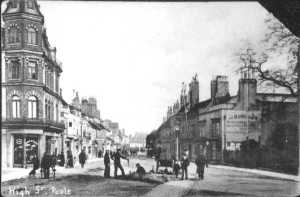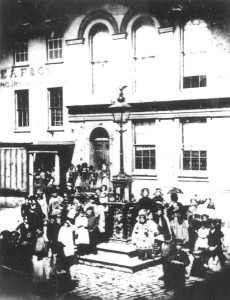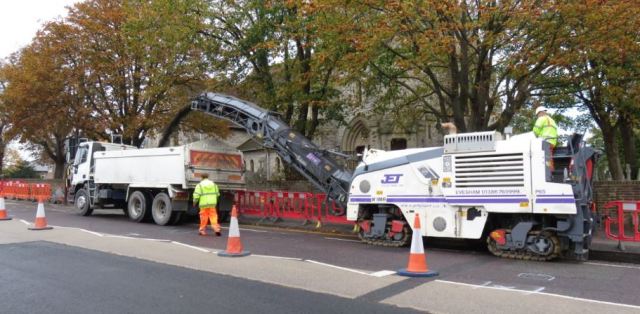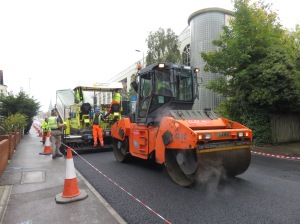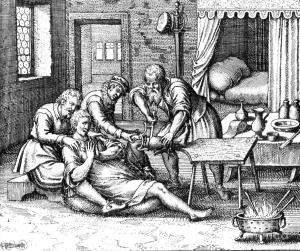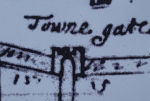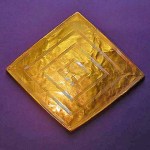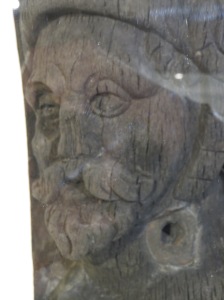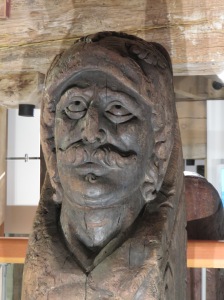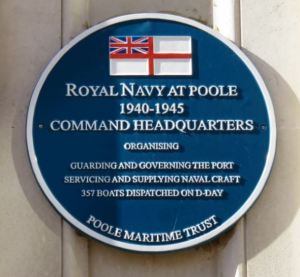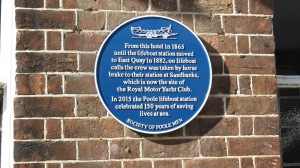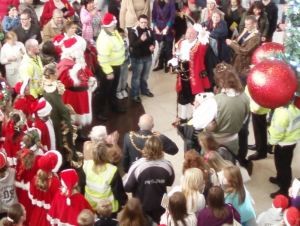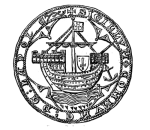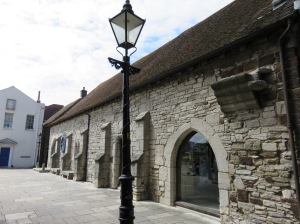 This article is a taster for the talk at Poole Museum ‘Alfred Russel Wallace: the Poole Years’ by Mike Brooke on Saturday 23rd July at 2.30pm which accompanies the World of Wallace exhibition currently showing in the Museum. (Tickets for the talk are available at the Museum or via j.oliver48@btinternet.com ). The article gives a glimpse into Wallace’s eventful early career.
This article is a taster for the talk at Poole Museum ‘Alfred Russel Wallace: the Poole Years’ by Mike Brooke on Saturday 23rd July at 2.30pm which accompanies the World of Wallace exhibition currently showing in the Museum. (Tickets for the talk are available at the Museum or via j.oliver48@btinternet.com ). The article gives a glimpse into Wallace’s eventful early career.
On 9th October 1852, the Hampshire Advertiser reported that the brig Jordeson, just docked at Deal, brought news of ‘the total destruction by fire of the English vessel Helen, bound from Para, South America.’ Captain Venables of the Jordeson had rescued the crew and single passenger of the Helen in mid Atlantic after 10 days in open boats, exposed to the fierce sun. However, their ordeal was not over. Supplies on board the Jordeson were low and the extra mouths to feed meant that food had to be severely rationed. In fact they might have starved if they had not managed to obtain supplies from a passing ship. As a final trial, the ship had to battle storms in the channel before finally docking at Deal.
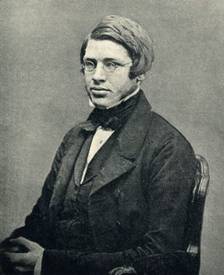
Alfred Russel Wallace as a young man
The sole passenger from the Helen was 29 year old Alfred Russel Wallace, returning to England after four years exploring the Amazon basin, observing and collecting natural history specimens. When fire broke out he had managed to save only a few of his possessions in a tin box but had lost all of his precious specimens of the last two years, which he believed to be worth £500, including his private collection with hundreds of new species of insects and birds. He had also lost most of his notes and drawings. It was a disastrous end to the trip.
Wallace’s family were not well off and he was obliged to earn his way from a young age. His formal education at Hertford Grammar School lasted only to the age of 13 and consisted mainly of learning facts by rote. He was however a keen reader with a practical and enquiring mind. After leaving school he worked in various jobs including land surveying with his brother William, a life which suited him. He developed an interest in astronomy and botany and started a collection of plant specimens. In 1844, he took a teaching post in Leicester which gave him the opportunity to learn mathematics and to use the Leicester Library where he read some of the major scientific works of the day. He also met Walter Henry Bates, a keen entomologist, specialising in beetles, who inspired him to start his own insect collection.
 In 1847, inspired by ‘A Voyage up the Amazon’ by W.H. Edwards, Wallace and Henry Bates planned a trip to South America to observe and collect the wildlife. They were assured by Edward Doubleday of the British Museum that there were many new and rare species to find and that they could cover their expenses by selling what they collected. They also found an excellent agent in Samuel Stevens, himself a keen collector. The Victorian passion for collecting was partly based on the ‘cabinet of curiosities’ fashionable in the previous century. With the spread of exploration, trade and empire, scientists and the general public alike became increasingly fascinated by foreign artefacts and exotic wildlife. Cases of stuffed birds, trays of butterflies and beetles and tableaux of animals in lifelike poses were to be found in many private houses, institutions and museums. Rare species were much in demand and could command high prices.
In 1847, inspired by ‘A Voyage up the Amazon’ by W.H. Edwards, Wallace and Henry Bates planned a trip to South America to observe and collect the wildlife. They were assured by Edward Doubleday of the British Museum that there were many new and rare species to find and that they could cover their expenses by selling what they collected. They also found an excellent agent in Samuel Stevens, himself a keen collector. The Victorian passion for collecting was partly based on the ‘cabinet of curiosities’ fashionable in the previous century. With the spread of exploration, trade and empire, scientists and the general public alike became increasingly fascinated by foreign artefacts and exotic wildlife. Cases of stuffed birds, trays of butterflies and beetles and tableaux of animals in lifelike poses were to be found in many private houses, institutions and museums. Rare species were much in demand and could command high prices.
Wallace and Bates sailed from Liverpool in April 1848. Wallace was 25 and Bates a couple of years younger. Both largely self taught, they epitomised the enterprising amateur naturalists exploring the world in the early 19th century. In Para they were excited by the abundance and variety of the local fauna. They quickly established a routine, hunting birds in the early morning and then insects until two or three in the afternoon. In the evening they preserved their specimens. Ironically, to a modern way of thinking, Victorian naturalists spent a lot of their time killing wildlife, although they did also observe the habits of the living creatures around them.

After a successful few months, the pair decided to separate to cover more ground. Wallace travelled further up the Amazon to the Rio Negro and Uaupes regions, observing the people and the wildlife and pondering ideas about the evolution or ‘transmutation’ of the different species. He also used his surveying skills to map the area. In 1849, Wallace’s brother, Herbert came out to Brazil to work with him but after a year it was clear that he was not cut out for the life, being of a more literary than scientific turn of mind. Herbert prepared to return to Para and England while Alfred set off on another trip up river. Sadly, Herbert caught yellow fever in Para and died after a few days, a fact not known to his brother for several months. In 1852, weakened by bouts of fever, Wallace finally decided to return to England and so embarked on the unfortunate Helen for what would prove to be a near fatal voyage.
Back in England, Wallace’s position seemed rather grim. The specimens sent back to England early in the trip would only cover his expenses, providing no profit, and the loss of his notes and drawings was a major blow. However, the insurance which Samuel Stevens had advised him to take out did provide £200 compensation and there were the letters which he had written home during the trip. Armed with these, his recollections and the notes that he had saved, he wrote ‘Travels on the Amazon and Rio Negro’, part travel book, part naturalist’s guide. Published in 1853, it did not make much of a profit but passages were quoted quite widely in the press:
 ‘Every night, while in the upper part of the river, we had a concert of frogs, which made most extraordinary noises. There are three kinds, which can frequently all be heard at once. One of these makes a noise something like what one would expect a frog to make, namely a dismal croak; but the sounds uttered by the others were like no animal noise that I ever heard before. A distant railway train approaching, and a blacksmith hammering on his anvil, are what they exactly resemble. They are such true imitations, that when lying half-dozing in the canoe I have often fancied myself at home hearing the familiar sounds of the approaching mail train, and the hammering of the boiler-makers at the iron-works.’
‘Every night, while in the upper part of the river, we had a concert of frogs, which made most extraordinary noises. There are three kinds, which can frequently all be heard at once. One of these makes a noise something like what one would expect a frog to make, namely a dismal croak; but the sounds uttered by the others were like no animal noise that I ever heard before. A distant railway train approaching, and a blacksmith hammering on his anvil, are what they exactly resemble. They are such true imitations, that when lying half-dozing in the canoe I have often fancied myself at home hearing the familiar sounds of the approaching mail train, and the hammering of the boiler-makers at the iron-works.’
Wallace made some useful contacts in London. He had gone out to the Amazon an unknown, but now he was in a position to meet eminent scientists like the biologist, Thomas Huxley. He attended meetings of the Zoological Society, Entomological Society and the Linnean Society and visited the British Museum and Kew gardens for his research. He also read a paper on ‘The Rio Negro and the Head Waters of the Amazon’ at a meeting of the Royal Geographical Society and presented his map of the area. When he came to plan his next trip, he was able to ask the President of the Royal Geographical Society, Sir Roderick Murchison, if he could arrange a free passage for him to Singapore.

Sir James Brooke
The destination that Wallace had chosen was the Malay Archipelago which he thought would be a rewarding place to study. He set off in the spring of 1854 for what was to be a trip of great significance to his own career and to the development of science. Over the next eight years, Wallace travelled to the different islands in the group, observing and collecting. In Sarawak he was welcomed by the Rajah, Sir James Brooke, a colourful British adventurer who had been appointed Rajah by the Sultan of Brunei after helping restore that monarch to his throne.
Wallace’s next objective was Sulawesi, via Lombok and Bali and from Sulawesi he took trips to the Moluccas and New Guinea. Later, he visited Java and Sumatra. Some of the smaller islands had never been visited by a European collector before and everywhere, Wallace found a wealth of new and interesting species. In each new location, he was quick to establish an efficient routine of collecting and preserving specimens but he was also interested in the lives and customs of the native people amongst whom he was living. In all, he travelled over 14,000 miles and collected around 125,660 specimens of which about 5,000 were new to European science. Several of these like the flying frog of Sarwak and the beautiful golden birdwing butterfly of the Maluku islands, would later be named after him.
 During his travels he began to notice that neighbouring islands contained ‘two different faunas rigidly circumscribed which differ as much as do those of Africa or South America’. He concluded that the eastern islands of the group had once been much further away from the western islands and closer to Australia. The boundary between the areas of different fauna was later to become known as Wallace’s Line. Wallace’s daily observation of different species also gave him a lot of material upon which to base his ideas about evolution. In 1855 he produced an ‘Essay on the Law which has regulated the Introduction of New Species’ which concluded that each new species to emerge required the presence of a ‘pre-existing closely-allied species’. He did not, however, attempt to explain the mechanism by which a new species was created. It was a bout of fever, leaving him too weak for the daily routine of collecting, which gave him the leisure to come up with a possible solution, as he later described:
During his travels he began to notice that neighbouring islands contained ‘two different faunas rigidly circumscribed which differ as much as do those of Africa or South America’. He concluded that the eastern islands of the group had once been much further away from the western islands and closer to Australia. The boundary between the areas of different fauna was later to become known as Wallace’s Line. Wallace’s daily observation of different species also gave him a lot of material upon which to base his ideas about evolution. In 1855 he produced an ‘Essay on the Law which has regulated the Introduction of New Species’ which concluded that each new species to emerge required the presence of a ‘pre-existing closely-allied species’. He did not, however, attempt to explain the mechanism by which a new species was created. It was a bout of fever, leaving him too weak for the daily routine of collecting, which gave him the leisure to come up with a possible solution, as he later described:
‘At that time I was suffering from a rather severe attack of intermittent fever at Ternate in the Moluccas, and one day while lying on my bed during the cold fit, wrapped in blankets . . . the problem again presented itself to me, and something led me to think of the “positive checks” described by Malthus in his “Essay on Population”, a work I had read several years before, and which had made a deep and permanent impression on my mind. These checks – war, disease, famine and the like – must, it occurred to me, act on animals as well as on man. Then I thought of the enormously rapid multiplication of animals, causing these checks to be much more effective in them than in the case of man; and while pondering vaguely on this fact there suddenly flashed upon me the idea of the survival of the fittest – that the individuals removed by these checks must be on the whole inferior to those that survived. In the two hours that elapsed before my ague fit was over I had thought out almost the whole of the theory, and the same evening I sketched the draft of my paper, and in the two successive evenings wrote it out in full, and sent it by the next post to Mr. Darwin.’
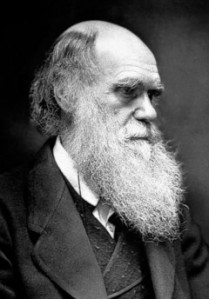
Charles Darwin
What followed is famous scientific history. When Darwin received the letter, he was dismayed to realise how closely Wallace’s ideas mirrored his own unpublished work. He consulted his friends, Sir Charles Lyall and Dr. Joseph Hooker who proposed a compromise. At a special meeting of the Linnean Society on 1st July 1858, part of Darwin’s work and a letter outlining his theory was read, followed by Wallace’s essay. Wallace did not hear about the meeting until later but his only regret was that he had not been able to correct and proof-read his work. At the time, the theory did not create much response, but the following year, Darwin produced his book ‘On the Origin of Species by Natural Selection’ which produced an increasing storm of controversy.
One of the main confrontations between supporters of Darwin’s (and Wallace’s) ideas and those who opposed them took place in Oxford at a meeting of the British Association on 30th June 1860, as reported in the Athenaeum:
‘The Bishop of Oxford came out strongly against a theory which holds it possible that man may be descended from an ape,—in which protest he is sustained by Prof. Owen, Sir Benjamin Brodie, Dr. Daubeny, and the most eminent naturalists assembled at Oxford. But others—conspicuous among these, Prof. Huxley—have expressed their willingness to accept, for themselves, as well as for their friends and enemies, all actual truths, even the last humiliating truth of a pedigree not registered in the Herald’s College. The dispute has at least made Oxford uncommonly lively during the week.’
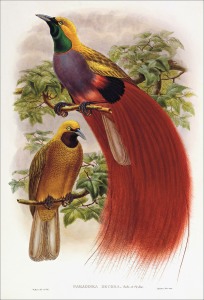
Birds of Paradise
By the time Wallace returned to England in 1862 (bringing with him two birds of paradise never before seen alive in Europe), enough time had passed for the public and the scientific community to get used to the ideas if not accept them. His return was very different from his previous return from Brazil. His name was now well known and respected in scientific circles and he had a store of notes and specimens to work upon and information to present. In December 1863, for instance, he gave a paper to the Leeds Literary and Philosophical Society ‘On the Varieties of Man in the Malay Archipelago’ in which he contrasted the Malays in the western islands with the Papuans in the east, as being very different in appearance and character. He suggested that the islands could be divided ‘by a vertical waving line through the Moluccas. . . This division was in harmony with that which had been shown to exist in the animal productions of the same region.’
 In 1866, Alfred Wallace married Annie Mitten, the daughter of a keen botanist, William Mitten. They were to have three children, Herbert, Violet and William, although Herbert died as a child. After spending some time sorting out his collections, he wrote possibly his most important book ‘The Malay Archipelago’, published in 1869. The Times’ review described it as ‘a careful and deliberately composed narrative, the fruits of 60 or 70 journeys made within the Malay Archipelago, journeys which occupied nearly eight years of time, and extended over a distance of 14,000 miles.’ Mr. Wallace had delayed publication while he sorted his collection of specimens ‘and scientific readers will all agree that this judicious delay has greatly enhanced the value of his work. Every page contains matter of interest; we shall there fore only attempt such a cursory survey of the numerous topics discussed as may induce those of our readers who have not seen the book to get it for themselves.’ One can imagine that Wallace was pleased with this review.
In 1866, Alfred Wallace married Annie Mitten, the daughter of a keen botanist, William Mitten. They were to have three children, Herbert, Violet and William, although Herbert died as a child. After spending some time sorting out his collections, he wrote possibly his most important book ‘The Malay Archipelago’, published in 1869. The Times’ review described it as ‘a careful and deliberately composed narrative, the fruits of 60 or 70 journeys made within the Malay Archipelago, journeys which occupied nearly eight years of time, and extended over a distance of 14,000 miles.’ Mr. Wallace had delayed publication while he sorted his collection of specimens ‘and scientific readers will all agree that this judicious delay has greatly enhanced the value of his work. Every page contains matter of interest; we shall there fore only attempt such a cursory survey of the numerous topics discussed as may induce those of our readers who have not seen the book to get it for themselves.’ One can imagine that Wallace was pleased with this review.
Wallace was to go on to publish a total of 22 books and innumerable papers, articles and essays. He remained an enthusiastic supporter of Darwinism and embraced many other interests including land nationalisation, socialism, and spiritualism. In 1882 he was present at Darwin’s funeral and acted as a pall-bearer, sharing the honour with two dukes, an earl and several eminent scientists. In 1885, he went on an extended lecture tour of the United States and Canada, even meeting the American president, Grover Cleveland. It was a far cry from the circumstances of his early life. He never became a wealthy man but a Civil List pension gave him some financial security. It was a kindly, enthusiastic and enquiring man who came to spend his retirement in Poole.
Jenny
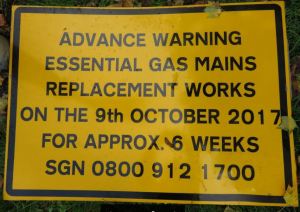 Recently I came across an estimate from 1843 for repairing and ‘Macadamizing’ parts of the High Street and it made me think of the difference between the process of road surfacing today and in early Victorian times. Everyone who has been into Poole in the last few months must have noticed that there have been a few road works in progress. Drivers into the town centre found themselves waiting in queues or undertaking unexpected little tours around the town centre, directed by lines of red barriers and bollards. At first the pattern changed every week but once the resurfacing started, it was every half day or even every couple of hours. Bus stops were in and out of use like yo-yos and pedestrians learned to watch out for traffic on the wrong side of the road, smoking tarmac beneath their feet and rapidly approaching rollers.
Recently I came across an estimate from 1843 for repairing and ‘Macadamizing’ parts of the High Street and it made me think of the difference between the process of road surfacing today and in early Victorian times. Everyone who has been into Poole in the last few months must have noticed that there have been a few road works in progress. Drivers into the town centre found themselves waiting in queues or undertaking unexpected little tours around the town centre, directed by lines of red barriers and bollards. At first the pattern changed every week but once the resurfacing started, it was every half day or even every couple of hours. Bus stops were in and out of use like yo-yos and pedestrians learned to watch out for traffic on the wrong side of the road, smoking tarmac beneath their feet and rapidly approaching rollers.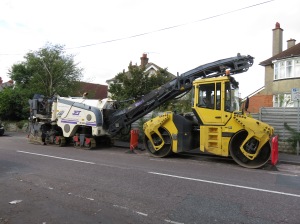 At one stage, the resurfacing vehicles were parked at the end of our road in all their colourful splendour. The most intriguing one was a strange hybrid beast with two sets of tracks, an extended body and a long conveyor belt stretching out in front. Each morning, the kitchen cabinets would start to vibrate as this machine trundled past, like some pre-historic creature from a dead-end branch of the evolutionary tree. Some minutes later it would trundle back in reverse, but the precise purpose of this excursion, I never discovered. However, I would get to see the beast in action a couple of days later.
At one stage, the resurfacing vehicles were parked at the end of our road in all their colourful splendour. The most intriguing one was a strange hybrid beast with two sets of tracks, an extended body and a long conveyor belt stretching out in front. Each morning, the kitchen cabinets would start to vibrate as this machine trundled past, like some pre-historic creature from a dead-end branch of the evolutionary tree. Some minutes later it would trundle back in reverse, but the precise purpose of this excursion, I never discovered. However, I would get to see the beast in action a couple of days later.
